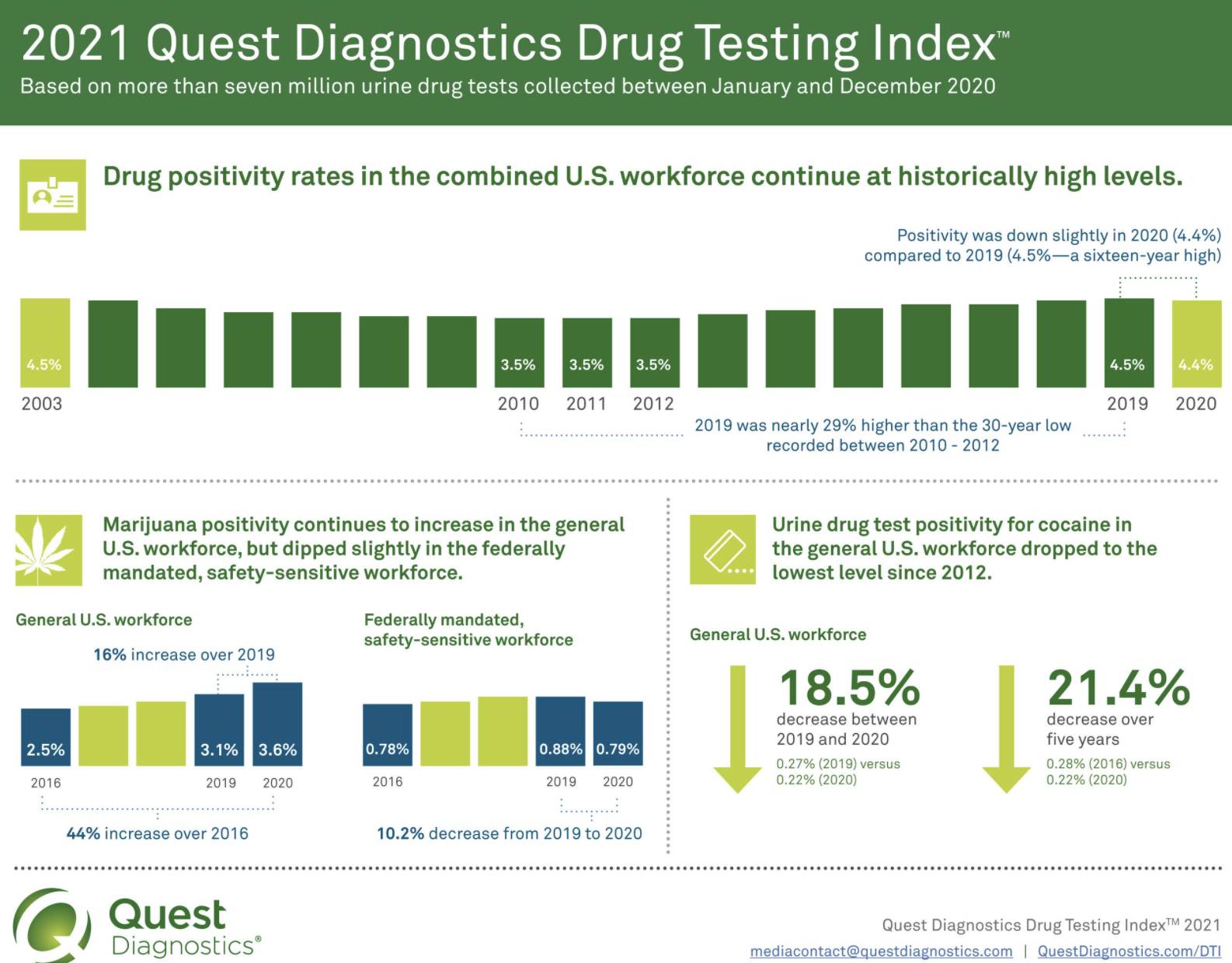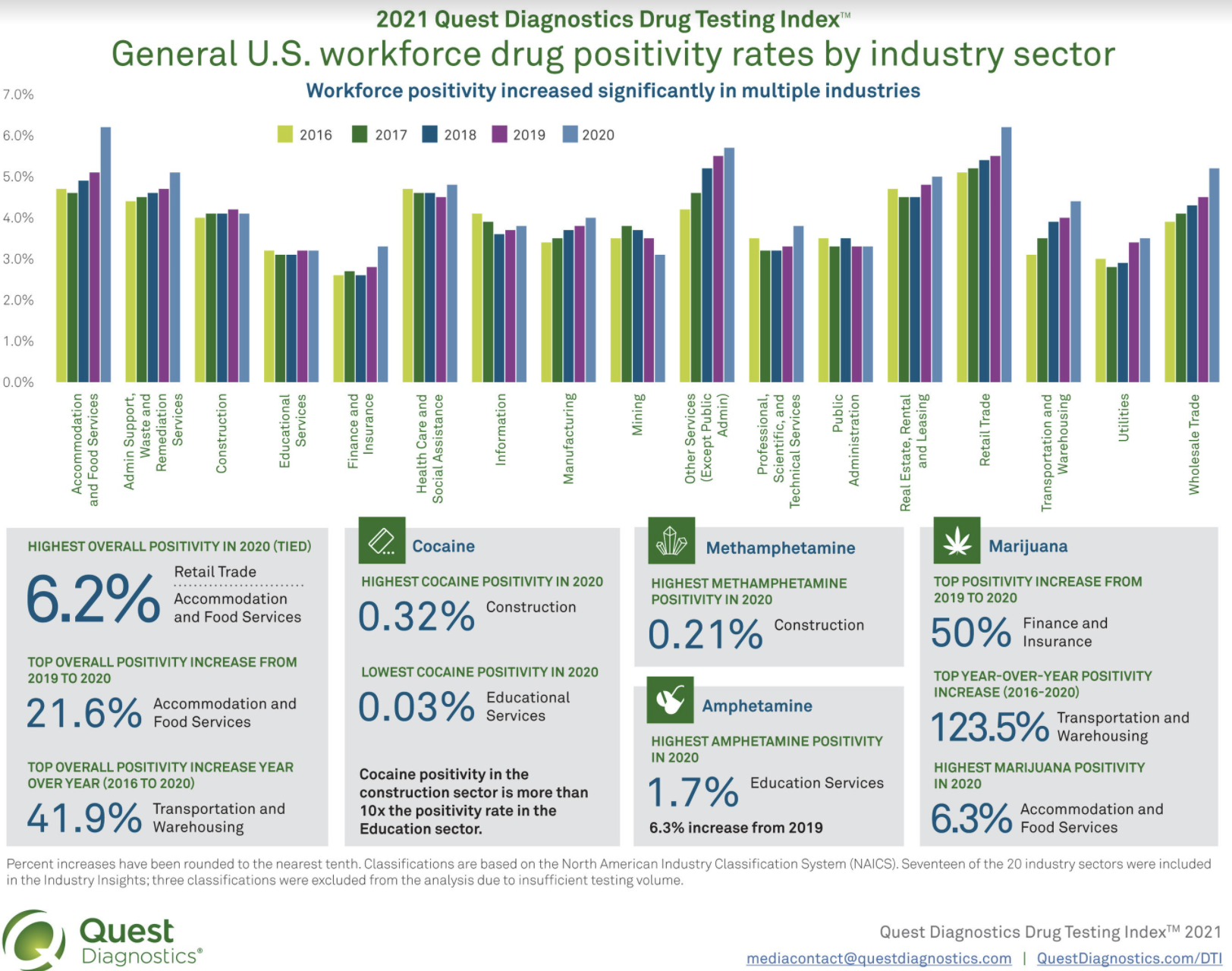Positive Drug Tests Down Except Marijuana, Quest Reports
From Quest Diagnostics


The COVID-19 pandemic did not dampen workforce drug testing positivity for marijuana, which continued to increase last year in the general U.S. workforce, according to a new analysis released May 26 by Quest Diagnostics.
The overall positivity rate in the combined U.S. workforce based on more than 7 million urine drug tests collected between January and December 2020 was down only slightly in 2020 (4.4%) compared to 2019 (4.5%, a sixteen-year high). Positivity in the federally mandated, safety-sensitive workforce based on more than 2 million urine drug tests declined 8.3% (2.4% in 2019 versus 2.2% in 2020) but was still 10% higher than the 2016 rate. In the general U.S. workforce, positivity increased 3.8% (5.3% in 2019 versus 5.5% in 2020) and was 12.2% higher than in 2016.
As positivity for most drug categories, other than marijuana, declined or remained flat in the combined U.S. workforce over the past five years, amphetamines, which includes methamphetamine, persisted at 1.1% positive each year.
Positivity down or flat for most categories
Positivity for cocaine declined 18.5% (0.27% in 2019 versus 0.22% in 2020), the semi-synthetic opiates (hydrocodone/hydromorphone) declined 10.8% (0.37% in 2019 versus 0.33% in 2020), oxycodone group of opiates (oxycodone/oxymorphone) declined 14.7% (0.34% in 2019 versus 0.29% in 2020), and benzodiazepines declined 9.3% (0.43% in 2019 versus 0.39% in 2020).
While the positivity for the drug commonly known as ecstasy increased by 25% (0.008% in 2019 versus 0.010% in 2020) and has demonstrated small, year-over-year increases, the positivity rate remains very low at one in every 10,000 tests.
Declines in federally mandated categories
Urine drug test results for the federally mandated, safety-sensitive workforce declined in all drug categories other than phencyclidine (PCP), which remained at 0.011%, same as in 2019. Of note, positivity for marijuana declined 10.2% (0.88% in 2019 versus 0.79% in 2020), cocaine declined 20% (0.25% in 2019 versus 0.20% in 2020), semi-synthetic opiates (hydrocodone/hydromorphone) declined 14.3% (0.35% in 2019 versus 0.30% in 2020) and the oxycodone group of opiates (oxycodone/oxymorphone) declined 19.2% (0.26% in 2019 versus 0.21% in 2020).
Marijuana positivity surged ahead in 2020 in the U.S. general workforce and across specimen types (urine, oral fluid, and hair). In the U.S. general workforce, marijuana positivity increased 16.1% in urine testing (3.1% in 2019 versus 3.6% in 2020), 35.2% in oral fluid testing (9.1% in 2019 versus 12.3% in 2020), and 22.5% in hair testing (7.1% in 2019 versus 8.7% in 2020).
Quest’s Drug Testing Index data showed stark differences between states that have legalized recreational marijuana use versus states that have only legalized medical marijuana use or no form of legal marijuana use. Marijuana positivity surged in states with legal recreational use statutes 118.2% from 2012 to 2020 (2.2% in 2012 versus 4.8% in 2020). In states with only medical marijuana statutes, marijuana positivity increased 68.4% (1.9% in 2012 versus 3.2% in 2020). In states with no medical or recreational marijuana statutes, marijuana positives increased 57.9% (1.9% in 2012 versus 3.0% in 2020).
Postaccident results
Between 2012, when the first state legalized recreational marijuana, and 2020, the gap between pre-employment and postaccident marijuana positivity increased each year. In the U.S. general workforce, in 2012, marijuana pre-employment positivity was 1.9% and postaccident positivity was 2.4% (a 26.3% difference). In 2020, pre-employment marijuana positivity was 3.7% and postaccident 6.4% (a 73% difference).
“The Drug Testing Index data shows states with recreational marijuana statutes have significantly higher positivity and the year-over-year differences between recreational states and states with medical and no legalization statutes has grown. In addition, while urine drug testing cannot determine whether an individual is under the influence or impaired at the time of test, our postaccident data suggests that marijuana use may play a role in those workplace incidents prompting a drug test,” said Barry Sample, Quest Diagnostics senior director of science and technology.
For more information, visit www.QuestDiagnostics.com.






